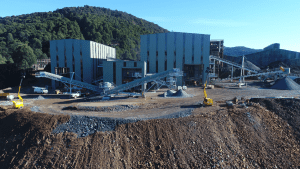Metals X, which owns a 50% stake in the Renison tin mine, Tasmania, through the Bluestone Mines Tasmania Joint Venture, saw revenue fall from $42.5 million to $36.5 million in the final quarter of 2018.
During Q4 of 2018, the operational focus at the Renison mine was on the commissioning and operation of the new ore sorting plant, along with continued exploration in Area 5 and the Leatherwood Trend, both of which are upcoming production zones. Commissioning of the three-stage optical ore sorting equipment began in the second quarter of last year and was completed in Q3. The equipment is comprised of a crushing, screening and ore-sorting stage, which concentrates the ore, increasing the head grade of the feed to the main ore processing plant. This was estimated to potentially increase production of tin-in-concentrate by some 15 – 20%.
During the final quarter of 2018, 186,243 tonnes of tin was mined at 1.25% Sn, an equivalent of 2,330 tonnes of tin contained. This is down 8% from 2,530 tonnes of tin contained during the third quarter of last year, despite a higher ore grade. However, results from the most recent quarter indicate that all the mined production is being processed, rather than being used to build up ore stockpiles, as was the case in Q3.
The quarterly results also show the benefit of the new ore sorting process. Despite mine production being down quarter-on-quarter, production of tin-in-concentrate rose some 10%, due in part to the increased head grade of feed into the ore processing plant (1.33% Sn during Q4 2018 vs 1.24% Sn during Q3 2018). In 2019, Metals X expect production of tin-in-concentrate to be between 7,500 – 8,000 tonnes.
Along with its mine works at Renison, Metals X has also been exploring the reprocessing of its tailings, known as the Rentails project. Although it had hoped to gain environmental approval for the project during the last year, Metals X will seek to lodge a Development Proposal and Environmental Management Plan (DPEMP) with the Tasmanian government during 2019. Key Rentails activities during the last quarter of 2018 were the continuation of environmental approvals and mining studies, as well as the associated geochemical tests. This information will be used to design the deconstruction and reconstruction of the tailings dam.
Our View: The decreased revenue from Renison compared to the same period the previous year is thought to be due to lower production, associated with the commissioning of the new ore sorting plant. However, production during the first quarter of 2019 appears promising, with the company reporting a record month for production during January, despite having to temporarily halt operations during the month due to bush fires.
The Rentails project is comprised of some 22.5 million tonnes of tailings, with an average grade of 0.44% Sn and 0.23% Cu. The Probable Ore Reserve for the project indicates a tin reserve of some 99,000 tonnes and a copper reserve of 51,000 tonnes. Should the DPEMP for the Rentails project be accepted, the tailings project will produce some 5,400 tonnes of tin and 2,200 tonnes of copper per year.



